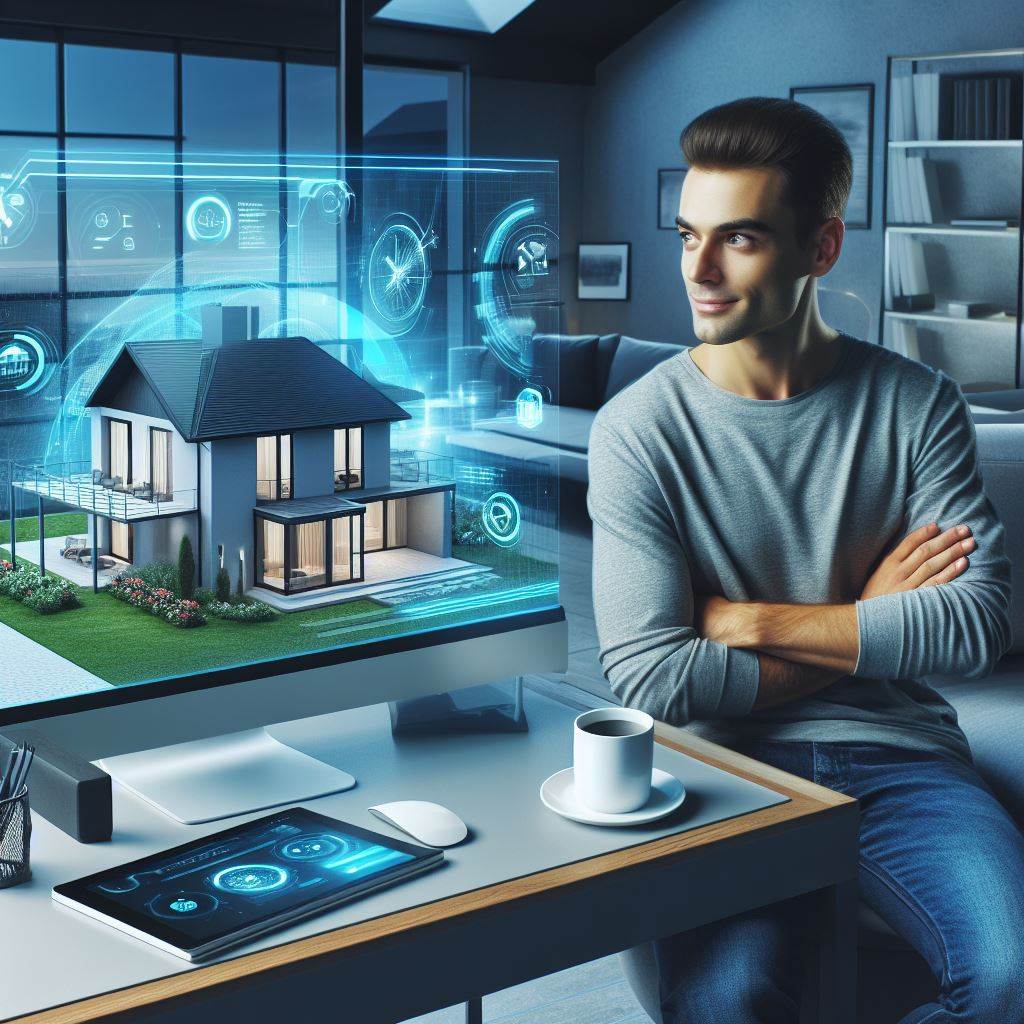Introduction
In recent years, AR technology has transcended its initial gaming applications and found a profound utility in various sectors, with real estate being a notable beneficiary.
This immersive technology allows potential buyers and investors to visualize properties in unprecedented ways, virtually placing them in the midst of their dream homes.
AR transforms traditional property listings into interactive, three-dimensional experiences.
Prospective buyers can navigate through properties, explore different rooms, and even envision potential interior designs.
This not only streamlines the decision-making process but also bridges the gap between imagination and reality.
Moreover, AR in real estate marketing goes beyond virtual property tours.
It enables the integration of additional information overlays, such as neighborhood details, nearby amenities, and future development plans.
Potential buyers can gain a comprehensive understanding of the property and its surroundings without physically being present, saving time and effort.
The immersive nature of AR also fosters engagement.
Real estate agents can utilize AR in marketing materials, creating interactive brochures or hosting virtual property showcases.
This not only captivates the audience but also establishes a unique and memorable brand presence.
As we navigate through this blog post, we will explore specific use cases, successful implementations, and the potential challenges associated with integrating AR into real estate marketing strategies.
By the end, readers will gain insights into the transformative power of AR and how it has become an indispensable tool in the ever-evolving realm of real estate marketing.
Definition and Explanation of AR
What Augmented Reality is in the context of real estate
Augmented Reality (AR) represents a cutting-edge technology that fundamentally alters how individuals perceive and interact with their surroundings.
Unlike Virtual Reality (VR), which immerses users in entirely simulated environments, AR overlays digital content onto the real world.
Transform Your Real Estate Decisions
Unlock personalized real estate insights crafted just for you. Get actionable advice designed to amplify your success.
Get StartedThis integration of virtual elements into physical reality blurs the lines between the digital and tangible, offering users a seamless blend of both realms.
In the context of real estate marketing, AR allows prospective buyers to visualize properties in unprecedented detail, superimposing digital renderings onto physical spaces.
This immersive experience enables potential buyers to explore properties remotely, gaining a comprehensive understanding of their layout, design, and potential.
How AR enhances the user’s perception of the physical world through digital elements
AR enhances the user’s perception of the physical world by superimposing digital elements onto their immediate environment in real-time.
This process transforms mundane spaces into interactive landscapes, where users can interact with virtual objects and information overlaid onto physical surfaces.
By bridging the gap between the digital and physical realms, AR creates immersive experiences that engage multiple senses simultaneously.
For real estate marketing, AR enables potential buyers to visualize properties in a realistic context, allowing them to assess factors such as scale, proportions, and spatial relationships.
This enhanced perception empowers users to make informed decisions about properties without physically visiting them, saving time and resources while increasing engagement and satisfaction.
How AR is currently being utilized in other industries
Across various industries, AR is revolutionizing how businesses engage with customers and deliver immersive experiences.
In retail, AR enables customers to try on virtual clothing and accessories, visualize furniture in their homes, and preview products before making purchasing decisions.
Also, in education, AR enhances learning experiences by creating interactive simulations, virtual field trips, and three-dimensional models that bring abstract concepts to life.
In healthcare, AR assists surgeons during procedures by overlaying patient data and medical images onto their field of view, improving accuracy and efficiency.
These examples illustrate the diverse applications of AR beyond real estate, highlighting its potential to transform industries and reshape human experiences.
Read: VR: Transforming Architectural Plans
Showcase Your Real Estate Business
Publish your company profile on our blog for just $200. Gain instant exposure and connect with a dedicated audience of real estate professionals and enthusiasts.
Publish Your ProfileBenefits of AR in Real Estate Marketing
In the competitive real estate market, utilizing technology to enhance marketing strategies is crucial for success.
Augmented Reality (AR) is one such technology that has proven to be immensely beneficial in the real estate industry.
This blog section explores the various advantages of integrating AR into real estate marketing campaigns.
Enhanced visualization for potential buyers/renters
Showcasing properties in a more immersive and interactive way
AR allows potential buyers or renters to visualize properties in a whole new dimension.
Instead of relying on static images or videos, AR technology provides a more realistic experience by overlaying virtual elements onto the real environment.
This allows users to explore properties as if they were physically present, enabling them to gain a better understanding of the space and its potential.
Allowing users to virtually decorate or customize a space
AR applications enable users to virtually decorate or customize a space according to their preferences.
With just a few taps on their smartphones or tablets, potential buyers or renters can experiment with different furniture arrangements, color schemes, and decor options in real-time.
This feature not only helps them visualize their future living space but also facilitates better decision-making.
Increased engagement and retention of potential clients
AR experiences create a memorable and unique impression
Implementing AR in real estate marketing campaigns creates a memorable and unique impression on potential clients.
By offering engaging AR experiences, such as virtual property tours or interactive floor plans, real estate agents can leave a lasting impact on buyers or renters.
This not only enhances brand recall but also increases the likelihood of clients choosing their services over competitors.
Higher chances of conversion due to increased engagement
AR experiences significantly increase engagement levels among potential clients.
The interactive nature of AR applications captures users’ attention and encourages them to spend more time exploring properties.
This extended engagement increases the chances of conversion, as potential clients are more likely to develop a deeper interest and connection with a property that they can actively interact with through AR.
In fact, integrating AR into real estate marketing campaigns offers numerous benefits.
From providing enhanced visualization of properties to increasing engagement and retention of potential clients, AR has revolutionized the way properties are marketed in the digital age.
By leveraging this technology, real estate agents can attract more buyers and renters, ultimately leading to successful transactions and a stronger market presence.
Read: Machine Learning: Changing Property Valuations

Use Cases and Applications of AR in Real Estate Marketing
In the digital age, technology has revolutionized the way real estate marketing is conducted.
Augmented Reality (AR), in particular, has emerged as a powerful tool for enhancing the marketing experience in the industry.
AR brings a host of exciting use cases and applications that elevate the way properties are presented to potential buyers.
In this section, we will explore the various ways AR is revolutionizing real estate marketing.
Virtual property tours
One of the most powerful applications of AR is virtual property tours. With AR, buyers can have a detailed and immersive virtual walkthrough of a property.
They can explore each room, examine the layout, and get a feel for the space without being physically present.
This feature is especially valuable for remote buyers who may find it challenging to visit properties in person.
By providing a realistic experience, AR empowers buyers to make more informed decisions about a potential property.
Moreover, virtual property tours have significant advantages in reducing the need for physical visits.
In the traditional real estate market, arranging physical visits for multiple properties can be time-consuming and inconvenient for both buyers and sellers.
However, with AR, buyers can screen properties virtually, narrowing down their options and saving time. AR eliminates the need for unnecessary physical visits, streamlining the buying process while ensuring a more efficient use of resources.
Showcase Your Real Estate Business
Publish your company profile on our blog for just $200. Gain instant exposure and connect with a dedicated audience of real estate professionals and enthusiasts.
Publish Your ProfileVirtual staging and interior design
Another area where AR is leaving its mark on real estate marketing is virtual staging and interior design.
Virtual staging involves using AR to showcase different interior design options for a space.
By simply pointing their devices at the room, buyers can visualize how it could look with various furniture styles, color schemes, and decor.
This feature allows buyers to envision the true potential of a property, helping them visualize their future home in a more personalized way.
Not only does virtual staging provide a more immersive experience for buyers, but it also presents a cost-effective alternative to physically staging properties for sale.
Traditional staging involves expensive furniture rentals and labor costs.
On the other hand, AR-based virtual staging eliminates the need for physical furniture and allows for quick changes, saving both time and money for sellers.
This cost-effective solution enables sellers to present their properties in the best possible light without breaking the bank.
Interactive neighborhood exploration
In addition to virtual property tours and staging, AR also enables interactive neighborhood exploration.
When considering a property, buyers often need information about nearby amenities, schools, transportation options, and other features of the surrounding neighborhood.
AR can provide all this information at the buyer’s fingertips.
By simply scanning the area with their devices, buyers can access relevant details about the neighborhood, ensuring they make a well-informed decision about the property’s location.
The power of AR in real estate marketing lies in its ability to enhance the buying experience.
Whether it’s through virtual property tours that eliminate barriers of physical distance, virtual staging that brings imagination to life, or interactive neighborhood exploration that provides valuable information, AR is transforming the way properties are marketed.
As technology continues to advance, the potential for AR in real estate marketing will only grow, creating exciting opportunities for both buyers and sellers in the industry.
Read: Enhancing Customer Service with AI in Realty
Challenges and Limitations of AR in Real Estate Marketing
When it comes to embracing Augmented Reality (AR) in real estate marketing, there are several challenges and limitations that need to be addressed.
These challenges mainly revolve around technology adoption and accessibility, initial setup and cost implications for real estate professionals, and privacy and security concerns.
Technology adoption and accessibility
AR applications heavily rely on the compatibility of hardware and devices.
This means that users may face challenges if their devices are not compatible with the AR application they are trying to access.
Additionally, those without AR-enabled devices or a strong internet connectivity may find it difficult to fully experience the benefits of AR in real estate marketing.
Initial setup and cost implications for real estate professionals
Real estate professionals who wish to implement AR technology into their marketing strategies need to invest in the necessary tools and equipment.
This initial setup can be financially burdensome for some professionals, especially smaller firms or individual agents.
It is important to carefully consider the cost of implementing AR and weigh it against the potential benefits it can bring to the marketing efforts.
Privacy and security concerns
As with any technology that involves personal data, AR in real estate marketing raises privacy and security concerns.
Virtual property tours, for example, may involve capturing sensitive information about individuals’ homes.
It is crucial to address potential issues related to data handling and ensure that user privacy is protected throughout the AR experience.
Implementing appropriate measures, such as secure data encryption and obtaining user consent for data usage, can help mitigate these concerns.
In a nutshell, while AR has the potential to enhance real estate marketing, there are challenges and limitations that need to be taken into account.
Technology adoption and accessibility, initial setup and cost implications, as well as privacy and security concerns, all play a significant role in the successful integration of AR in real estate marketing strategies.
Showcase Your Real Estate Business
Publish your company profile on our blog for just $200. Gain instant exposure and connect with a dedicated audience of real estate professionals and enthusiasts.
Publish Your ProfileBy addressing these challenges and implementing appropriate measures, real estate professionals can embrace AR technology while ensuring a seamless and secure experience for their users.
Read: AI in Real Estate: Transforming Market Analysis
Conclusion
The future of real estate marketing is poised for remarkable growth with the integration of Augmented Reality (AR).
Expanding consumer expectations will fuel this evolution.
AR in real estate marketing offers tangible benefits, from immersive property tours to interactive neighborhood exploration.
It caters to the modern buyer’s demand for a dynamic and engaging experience.
Despite its potential, challenges such as technological barriers and cost implications exist.
However, these hurdles are dwarfed by the prospect of gaining a competitive edge in the market.
AR presents an unparalleled opportunity for real estate professionals to revolutionize their marketing strategies.
The ability to showcase properties in innovative ways and provide interactive experiences will reshape the industry landscape.
Embracing AR is not just a trend; it’s a strategic imperative. The market is becoming increasingly saturated, and standing out is crucial.
By leveraging AR technology, real estate professionals can differentiate themselves, attract more clients, and ultimately close deals more effectively.
As we conclude, it’s essential for industry stakeholders to recognize the transformative power of AR and make a concerted effort to integrate it into their marketing arsenal.
The time to embrace this cutting-edge technology is now.
The future belongs to those who innovate and adapt, and AR is undoubtedly the next frontier in revolutionizing real estate marketing.




